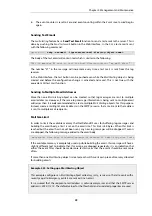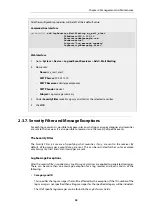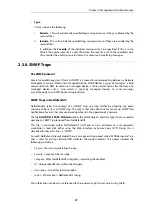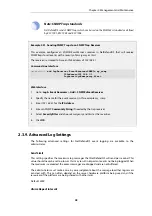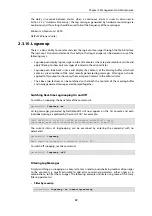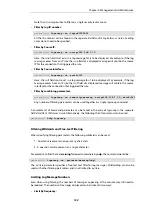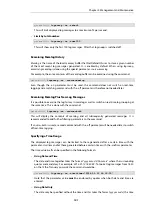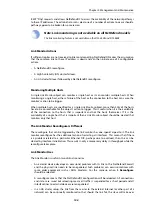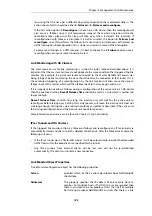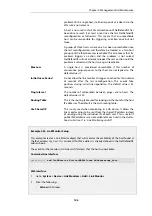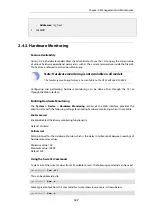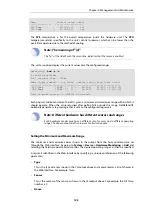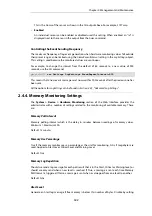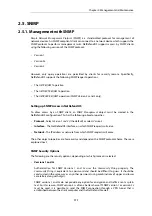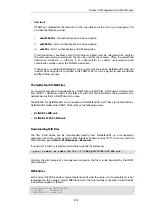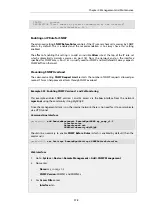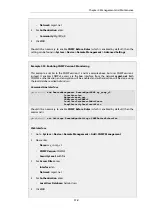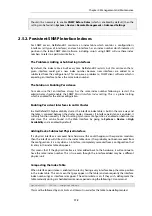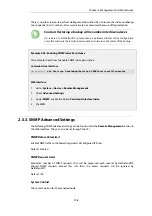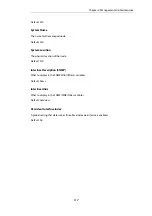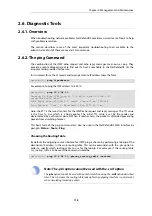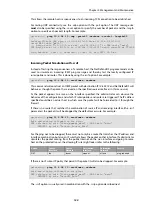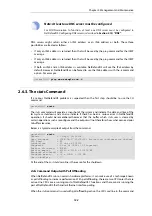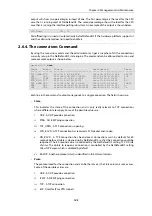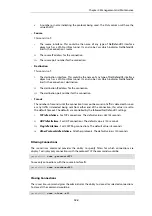
This is the
Name
of the sensor as shown in the CLI output above. For example,
SYS Temp
.
•
Enabled
An individual sensor can be enabled or disabled used this setting. When enabled, an "
(x)
" is
displayed next to the sensor in the output from the
hwm
command.
Controlling the Event Sending Frequency
The maximum frequency of log event generation when hardware monitoring values fall outside
their preset range can be limited using the
AlarmRepeatInterval
setting in the
LogSettings
object.
This setting is used because the monitored values are continuous.
For example, to change the interval from the default of 60 seconds to a new value of 900
seconds, use the CLI command:
gw-world:/> set Settings LogSettings AlarmRepeatInterval=900
This means that a new event message must now wait for 900 seconds after the previous one has
been sent.
All the options for
LogSettings
can be found in
Section 2.3.9, “Advanced Log Settings”
2.4.4. Memory Monitoring Settings
The System > Device > Hardware Monitoring section of the Web Interface provides the
administrator with a number of settings related to the monitoring of available memory. These
are:
Memory Poll Interval
Memory polling interval which is the delay in minutes between readings of memory values.
Minimum 1, Maximum 200.
Default:
15 minutes
Memory Use Percentage
True
if the memory monitor uses a percentage as the unit for monitoring,
False
if megabytes are
used. Applies to Alert Level, Critical Level and Warning Level.
Default:
True
Memory Log Repetition
Should we send a log message for each poll result that is in the Alert, Critical or Warning level, or
should we only send when a new level is reached. If True, a message is sent each time Memory
Poll Interval is triggered. If False, a message is sent when a value goes from one level to another.
Default:
False
Alert Level
Generate an Alert log message if free memory is below this number of bytes. Disable by setting
Chapter 2: Management and Maintenance
109
Summary of Contents for NetDefendOS
Page 30: ...Figure 1 3 Packet Flow Schematic Part III Chapter 1 NetDefendOS Overview 30 ...
Page 32: ...Chapter 1 NetDefendOS Overview 32 ...
Page 144: ...Chapter 2 Management and Maintenance 144 ...
Page 284: ...Chapter 3 Fundamentals 284 ...
Page 392: ...Chapter 4 Routing 392 ...
Page 419: ... Host 2001 DB8 1 MAC 00 90 12 13 14 15 5 Click OK Chapter 5 DHCP Services 419 ...
Page 420: ...Chapter 5 DHCP Services 420 ...
Page 573: ...Chapter 6 Security Mechanisms 573 ...
Page 607: ...Chapter 7 Address Translation 607 ...
Page 666: ...Chapter 8 User Authentication 666 ...
Page 775: ...Chapter 9 VPN 775 ...
Page 819: ...Chapter 10 Traffic Management 819 ...
Page 842: ...Chapter 11 High Availability 842 ...
Page 866: ...Default Enabled Chapter 13 Advanced Settings 866 ...
Page 879: ...Chapter 13 Advanced Settings 879 ...

